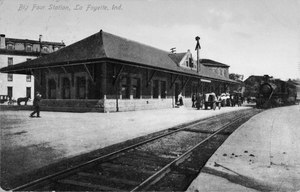Lafayette, IN | |||||||||||||||||||||||||||||||||||||||||||||||
|---|---|---|---|---|---|---|---|---|---|---|---|---|---|---|---|---|---|---|---|---|---|---|---|---|---|---|---|---|---|---|---|---|---|---|---|---|---|---|---|---|---|---|---|---|---|---|---|
 Lafayette's historic Amtrak station in 2009; it was originally a "Big Four" Depot. | |||||||||||||||||||||||||||||||||||||||||||||||
| General information | |||||||||||||||||||||||||||||||||||||||||||||||
| Location | 200 North 2nd Street Lafayette, Indiana United States | ||||||||||||||||||||||||||||||||||||||||||||||
| Owned by | City of Lafayette | ||||||||||||||||||||||||||||||||||||||||||||||
| Line | CSX Lafayette Subdivision | ||||||||||||||||||||||||||||||||||||||||||||||
| Platforms | 1 side platform | ||||||||||||||||||||||||||||||||||||||||||||||
| Tracks | 3 | ||||||||||||||||||||||||||||||||||||||||||||||
| Connections | |||||||||||||||||||||||||||||||||||||||||||||||
| Construction | |||||||||||||||||||||||||||||||||||||||||||||||
| Parking | Yes | ||||||||||||||||||||||||||||||||||||||||||||||
| Bicycle facilities | Yes | ||||||||||||||||||||||||||||||||||||||||||||||
| Accessible | Yes | ||||||||||||||||||||||||||||||||||||||||||||||
| Other information | |||||||||||||||||||||||||||||||||||||||||||||||
| Station code | Amtrak: LAF | ||||||||||||||||||||||||||||||||||||||||||||||
| History | |||||||||||||||||||||||||||||||||||||||||||||||
| Opened | 1902 | ||||||||||||||||||||||||||||||||||||||||||||||
| Rebuilt | 1994 | ||||||||||||||||||||||||||||||||||||||||||||||
| Passengers | |||||||||||||||||||||||||||||||||||||||||||||||
| FY 2024 | 5,029 [1] (Amtrak) | ||||||||||||||||||||||||||||||||||||||||||||||
| Services | |||||||||||||||||||||||||||||||||||||||||||||||
| |||||||||||||||||||||||||||||||||||||||||||||||
| |||||||||||||||||||||||||||||||||||||||||||||||
| |||||||||||||||||||||||||||||||||||||||||||||||
Big Four Depot | |||||||||||||||||||||||||||||||||||||||||||||||
 c. 1910 Big Four Depot | |||||||||||||||||||||||||||||||||||||||||||||||
 | |||||||||||||||||||||||||||||||||||||||||||||||
| Coordinates | 40°25′7″N86°53′44″W / 40.41861°N 86.89556°W | ||||||||||||||||||||||||||||||||||||||||||||||
| Area | 8 acres (3 ha) | ||||||||||||||||||||||||||||||||||||||||||||||
| Architect | Buckeye Chum Company | ||||||||||||||||||||||||||||||||||||||||||||||
| Architectural style | Romanesque | ||||||||||||||||||||||||||||||||||||||||||||||
| NRHP reference No. | 03000548 [2] | ||||||||||||||||||||||||||||||||||||||||||||||
| Added to NRHP | June 22, 2003 | ||||||||||||||||||||||||||||||||||||||||||||||
| |||||||||||||||||||||||||||||||||||||||||||||||
Lafayette station is an Amtrak station in Lafayette, Indiana, served by the Cardinal . The current station facility was established in 1994. The Amtrak train previously stopped in the middle of the city's 5th Street, near the former Monon Railroad depot. [3] The station building was moved to its current location from the southeast corner of 2nd and South streets in September 1994. [4] It is a Romanesque Revival style depot built in 1902 by the Lake Erie and Western Railroad and Cleveland, Cincinnati, Chicago and St. Louis Railway, [5] as the Big Four Depot. [6] The station was listed on the National Register of Historic Places in 2003. [2]




